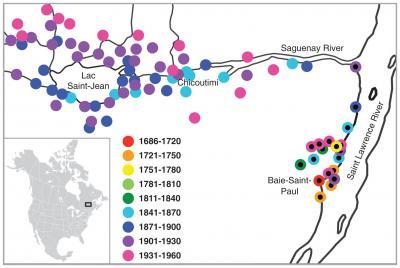New research into the genealogies of early human pioneers suggests that the settlers who were first to colonize a new region of the world produced more offspring than the settlers who followed them.
Until now, few studies have explored such consequences of range expansion on the modern human genome. But, Claudia Moreau from Hôpital Sainte-Justine at the Université de Montréal, along with colleagues from the Université du Québec à Chicoutimi, the University of Berne and the Swiss Institute of Bioinformatics, made this discovery after studying the expansion of human colonies in Quebec, Canada, between 1686 and 1960.
Using old church registries, the researchers analyzed the genealogy of individuals who settled in Quebec and married there. They found that the settlers who colonized a new region of Quebec had significantly more children than those who lived within the center, or core, of an existing colony.
Their study was published in Science.
"Moreau and colleagues have examined genealogies of a complete population occupying a recently settled region of Quebec using records that date as far back as the 17th century, comprising over one million individuals," said Laura Zahn, Senior Editor at the journal Science. "We are pleased to present this ground-breaking work on the interaction of geographic expansion and genetics of human expansions."

Achille Bhérer and Hortense Gaudreault photographed in 1876 in Charlevoix with seven of their 14 children.
(Photo Credit: Picture courtesy of the Bhérer Family)
These early, fertile pioneers lived on the so-called "wave front," or the edge of the expansion range, during their colonization of Quebec. They were the first generation of settlers to occupy an otherwise uninhabited region.
"The wave front is a moving edge," explained Laurent Excoffier, the corresponding author of the report. "This wave front is always at the periphery of the range. So, individuals begin by colonizing a given region, which becomes the wave front by definition. Then, people send migrants toward new regions, which become the wave front in turn… and when a given territory has been fully settled, the wave front disappears since there is no wave of advance anymore."
Moreau and the researchers found that the majority of people currently living in the Saguenay-Lac-Saint-Jean region of Quebec are related to ancestors who lived on — or close to — the wave front of colonization.
The researchers also discovered that women who settled on the wave front had 15% higher fertility rates than women who joined their colonies later. They suggest that this might be because, on average, women on the wave front married one year earlier than women who settled into the core of the population.

The full descent of their son, Edgar Bhérer, married to Délina Boivin. The picture was shot in 1960 for the celebration of Edgar and Délina 50th wedding anniversary in front of the family house in St-Félicien, Lac-Saint-Jean.
(Photo Credit: Picture courtesy of the Bhérer Family)
"The registries gave us information on the parents of all married individuals, including the time and place of their marriage," said Excoffier. "The number of children those individuals had could be deduced from the data… We could actually count how many children each woman had, both on the wave front and in the core of the population."
Since this increased reproductive success only seems to occur on the wave front, the researchers argue that fertility is a trait that can rapidly evolve during range expansion, passing from one generation to the next.
"We think this heritability on the wave front and not in the core population is due to the fact that there is some competition for resources in the core, which prevents members of large families to access land and to get married early," said Excoffier. "Since there is more land available on the front, there is less competition and, thus, this correlation persists there."

Map of Charlevoix Saguenay Lac-Saint-Jean region showing the range expansion dynamics and the wave front at different periods. Each filled circle represents a locality and its color indicates its age. Localities from the Charlevoix region are indicated by a black dot.
(Photo Credit: Image courtesy of Science/AAAS)